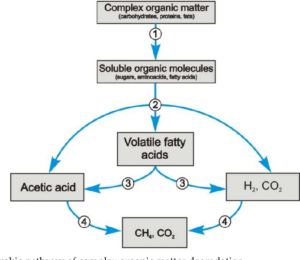
Anaerobic Treatment and Biogas Production from Organic Waste – G. Zupančič, V. Grilc
Biochemistry of organic acids formation
- Anaerobic conditions – terminal electron acceptor is an organic compound rather than O2, NOx or SOx. Results in XCOOH (organic acids) & alcohols – this is called anaerobic or fermentative respiration
- Formed in collection systems, equalization basins/tanks, anoxic/anaerobic lagoons, and non-aerated tanks
- Key concept here is organic acids are soluble organics and readily go across bacterial cell walls.
Good side of organic acids in wastewater
- Key to making carbon dioxide, hydrogen, and acetic acid used by methanogens in anaerobic digesters.
- Short chain organic acids are key to fueling biological phosphorus removal
- Start biodegradation of insoluble compounds such as Fats, Oils & Grease – in grease traps & lift stations the “grease” is often long chain fatty acids (insoluble) that are left after the first stages of anaerobic respiration. Lipases remove glycerol and leave the fatty acids in first stages.
Problems related to wastewater organic acids
- Short chain volatile organic acids (acetic, butyric, and propionic) can cause odor complaints
- Are a preferred “food” source for many filaments and non-filamentous bulking organisms (Zooglea forms)
- High concentrations appear to have negative impact on AOB & NOB growth
